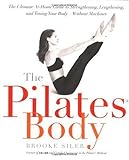The Complete Guide to Joseph H. Pilates’ Techniques of Physical Conditioning
This book is by Allan Menezes, founder of the Pilates Institute of Australiasia.
He was an active athlete in college, but in 1980 injured his back in a rugby game. It was so severe it had to lie in a hospital bed for ten days, fed only on liquids. He had a diagnosis of a slipped disc. He believes he badly ruptured the muscles on the left side of his spine. For two years, any pressure on that side gave him extreme pain in his lower back. He went to many doctors and practitioners, without success.
In London in 1982 his father referred him to the Alan Herman Studios, where Alan Herman got him started on Pilates. After attending classes every day for six week, his back pain disappeared.
As a male athlete, though, he wanted to go beyond the techniques that Pilates used with his (mostly) female dancers. He developed routines for improving his own game in squash, volleyball and other games. He also developed them for other athletes.
In 1986 he established the first Pilates studio in the Southern Hemisphere, the Body Control Pilates Studios in Sydney Australia. In 1996 he founded the Pilates Institute of Australasia.
This book begins, as many books on Pilates do, with a brief introduction to Joseph Pilates and his work. He expresses his belief that if Pilates were still alive, he’d be improving his past work. Some Pilates instructors try to carry on just with the way Pilates always did things. Others will try new things from other disciplines, or modify the original work based on new medical discoveries. Also, as the author notes, we’re now less physically fit on average than the people Joseph originally worked with.
He goes on to explain how exercise can benefit us, pointing out the negative effects of stress and how we let poor movement become a chronic problem, so we have out of balance problems and poor posture, and how this affects our health.
He discusses the benefits of exercise and having a positive mental attitude.
Unfortunately, he also mentions how aging can show from wear and tear on our bodies and joints. That sounds like our joints just wear our like machine parts, and that’s not strictly true. Our bodies are capable of endlessly regenerating cartilage and repairing worn tendons and strained muscles — if given a chance.
As many Pilates books do, he goes into an anatomy lesson — more extensive than most, though as not as much as others. He doesn’t emphasize the Core or Powerhouse as a whole, but does talk a lot about the B-Line, which run horizontally through you just below the tops of your hip bones, about two or three inches below your navel.
And, again like many Pilates books, he devoted space to the importance of posture, which Pilates emphasizes more than any other exercise system I know of.
Then he explains eighty exercises for the mat, divided into sample workouts that work their way up in difficulty. He ends with a chapter with theraband exercises. That, and a few simple weights, is the only equipment in this book. It’s not the place to learn about the Pilates Reformer or other accessories.



